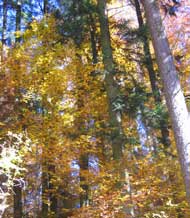
The European wood products sector occupies a prominent position in the European economy. Using wood as its prime raw material, it forms an integral part of the bio-economy and, as such, contributes greatly to achieving the major policy goals the EU has set itself. Within the context of this exhibition at the European Parliament, focus is put on the sector's raw material use, on the contribution of wood products to the mitigation of climate change, on the achievement of resource efficiency, and on the actions taken by the sector in this respect.
Europe's forest cover
Europe has 1005 million hectares (ha) of forest spread over 46 countries, equivalent to 25% of the global forest and to 1.4 ha (more than two football pitches) per capita. Although the Russian Federation accounts for over 80% of this forest area, EU forest cover averages 45% per country while the 27 EU countries (EU 27) have an average forest cover of 37.6 %, amounting to 157 million ha of forest.
Europe's forest growth
The forest area in all European regions has increased since 1990. Europe is the only region to have had a positive net change in forest area for the past 20 years. Europe has gained 5.1 million ha of forest and other forest land since 2005 and 16.69 million ha since 1990. The total standing volume in Europe in 2010 amounted to 96,252 million cubic metres, 21,750 of which are in EU 27 countries. The net annual increment of EU 27 is estimated at 620 million cubic metres. In practice just 64% of the net annual increment is harvested.
The basis: sustainable forest management
Due to the wide variety of historical, demographic, economic, climatic and ecological circumstances, different management and regeneration methods are used across Europe – from large scale regeneration felling in uniform coniferous monocultures to group, or even single tree, selection systems in mixed or broadleaved forests. European forestry management is moving towards methods that enhance natural processes and produce authentic forest structures which are environmentally appropriate, socially beneficial and economically viable. More and more often forests are third-party certified for sustainable management practices, FSC (Forest Stewardship Council) and PEFC (Programme for the Endorsement of Forest Certification) schemes being the most prominent certification schemes. Furthermore, almost 39 million ha or 18% of the European forest area (excl. Russia) are set aside to conserve ecological and landscape diversity. More than 2.3 million ha are strict forest reserves, with no active human intervention. 85-90% of the forest area of Europe is used for economic, recreational, and other multiple-use purposes and also helps to protect the soil, water, and other ecosystem functions, such as biodiversity, air quality, climate change and land stability. The European forestry industry recognises that its future is inextricably linked with the protection and expansion of its forests. This, coupled with strong and effectively-enforced laws, ensures that more trees are planted than are harvested. All European countries have policies and practices requiring reforestation. Although the number of trees planted per hectare will vary depending upon the species, site and management system, it will always be more than the number felled, in order to allow for natural losses and for the forest to be well stocked. Therefore there should be no confusion between deforestation in tropical regions, e.g. due to poverty or forest conversion for agricultural purposes, and forest management practices in Europe. As stated earlier, only 64% of the annual increment of European forests is harvested and the forest area is constantly increasing. Left entirely to nature, forests will achieve a climax stage. At this point the forest only grows as trees fall due to age, wind, landslip, disease or fire. Although natural regeneration will occur, the dead and dying trees will decay or burn, emitting CO2 from the stored carbon. Growth is matched by decay and, with no forest management, there is no net increase in carbon storage. Harvesting trees as they mature allows much of their carbon to be stored throughout the life of the resulting wood products, while at same the time giving the industry an incentive to plant new trees in their place. Sound forest management and use of the wood produced are, therefore, the best guarantee to secure Europe's forests for decades to come and guarantee income for the forest owners, and raw material for the wood industry. In addition, many European countries are now using green public procurement policies to guarantee that wood and wood products come from sustainable forest management. It is important to appreciate that over 90% of Europe's wood consumption is sourced from European forests which are characterised as 'generally stable, well managed and in surplus production'. The consumer or specifier can therefore be reasonably sure of the environmental credentials of their product. With the implementation of the European Union Timber Regulation (995/2010/EC) in March 2013, prohibiting for the first time the placing on the EU market of illegally harvested timber and products derived from such timber, further reassurance will be given to the consumer that wood and wood products found on EU markets are legal.
